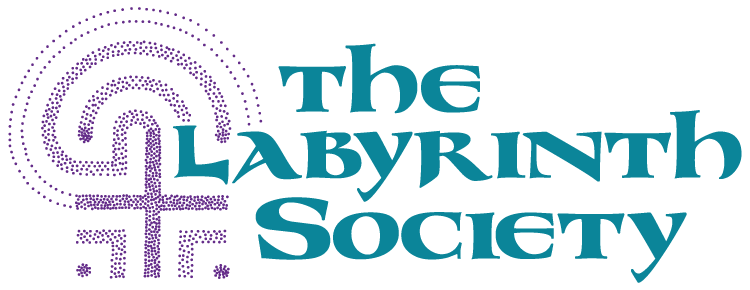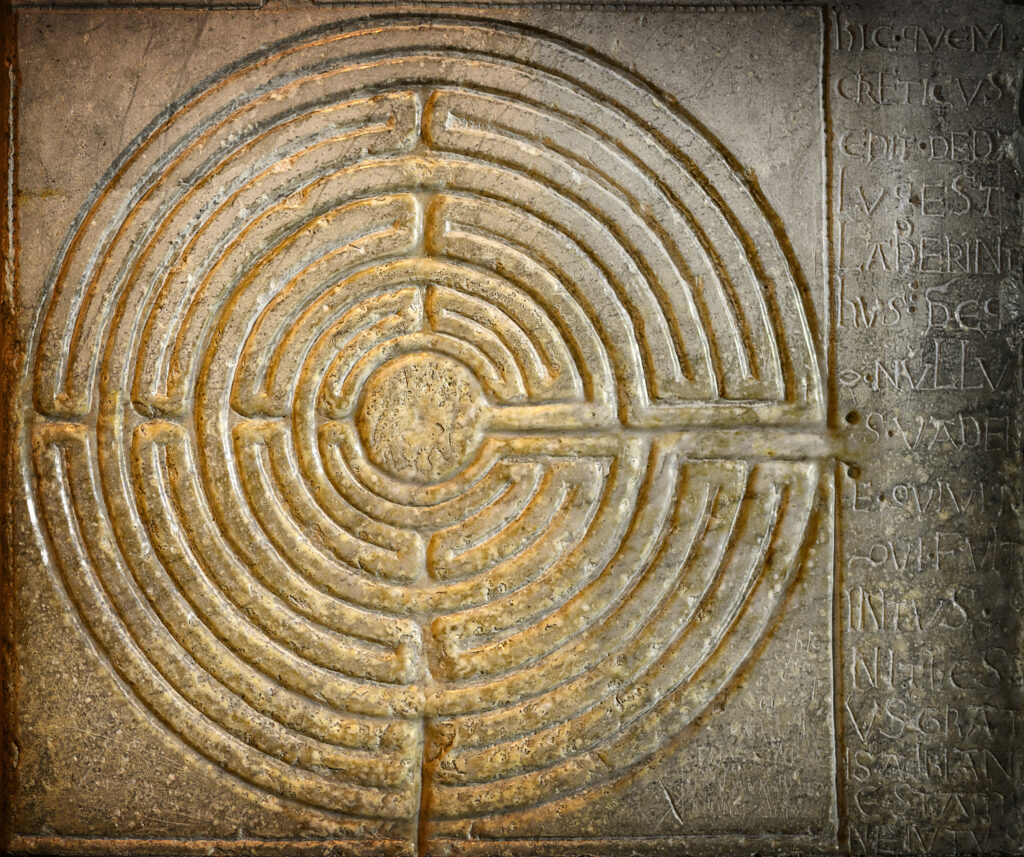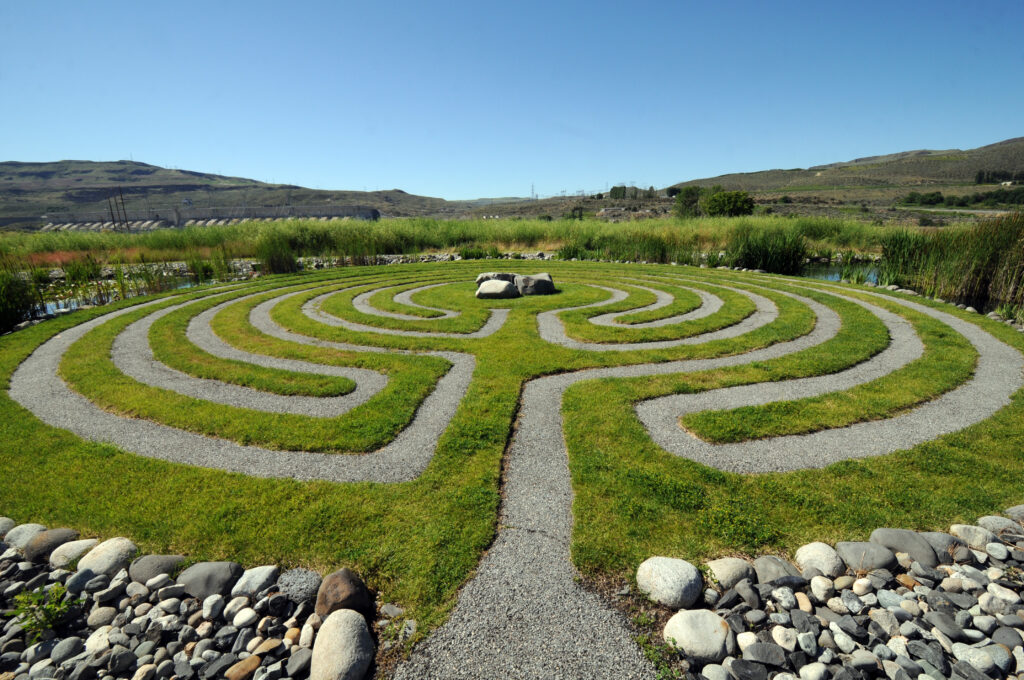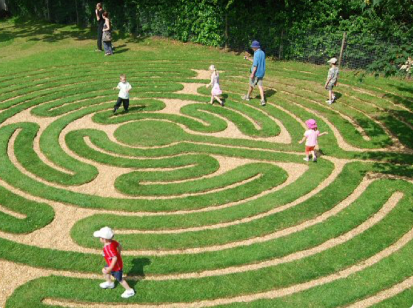Introduction
This section of ‘Labyrinths in Use’ presents the creation and use of labyrinths in Higher Education. Written from an international perspective, it includes labyrinths in North America, Asia, Australasia, and Europe.
As the primary author of this section is British, please note that the word staff is used in the British sense, inclusive of faculty and other colleagues. Since the turn of the century, many permanent labyrinths have been created in university and college settings. Sometimes these are built specifically to enhance the campus environment as beautiful landscape features, and sometimes as memorials or as part of a Chaplaincy initiative. There are now exciting developments in wider use of permanent or ephemeral labyrinths on campus – and also in city universities that do not identify as campus-based. Labyrinths are being used in different, creative ways, within and beyond academic disciplines: as part of teaching and learning, for staff and student development, and as the topic of research or to support the research process.
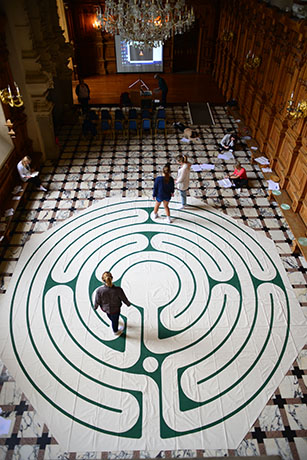
The labyrinth is a powerful and beautiful resource that can become wellsprings of quietness and peace in our universities and colleges, and for the wider community. The growing interest in labyrinths in academic contexts shows no sign of abating: we invite you to explore these pages, to share your own ideas and – not least – to record and write about your findings and experiences. This field is under-researched and the possibilities are wide-ranging. For more on this, see the closing webpage in this section, and The Labyrinth Society’s call for researchers on this website.
If you are looking for a particular university labyrinth, or any labyrinths associated with universities, please visit the World Wide Labyrinth Locator. You can filter your search by using the key words ‘university’ or ‘college’, though some of these are churches or medical centres associated with, or near, a university. For a broader search, use the filter for ‘School or Educational Centre’.
Arts, Health and Wellbeing workshop, Marian University Summer School, Harlaxton College, England
Prepared for the Labyrinth Society by Jan Sellers, lead editor of Learning with the Labyrinth: Creating reflective space in higher education (Sellers and Moss, 2016). Web pages revised 2018 by Jan Sellers, Jodi Lorimer, and Diane Rudebock.
We will be glad to hear from you: please visit the Research area of the TLS website or Jan Sellers’ website.
Bringing a Labyrinth to a University
If you are interested in bringing a labyrinth into a university setting, you’ll need to find ways in which your own work, experience and expertise make a connection with a particular academic discipline, or another function within the University. Your starting point will depend on whether you are already working, or studying, within a university or an organisation connected to Higher Education, or are coming in from outside the institution. Because universities are often very large, you may find interest in one corner – and complete lack of interest in another.
Look for common ground and for tangential connections which may prove to be useful. In addition to academic departments, schools or sections, think about links with different teams (names will vary):
- Arts initiatives
- Careers and other guidance teams
- Chaplaincy – inter-faith or single faith
- Counselling and Wellbeing Services
- Health and Medical Centres
- Grounds, environment, garden and arboretum teams
- Personnel Department
- Recruitment (of students) and Widening Participation initiatives
- Personal, Professional and Staff Development
- Students’ Union and Student Societies
- Student volunteer and other service initiatives
- Teaching and learning development
- Alumni associations.
The more relevant and focused your proposal, the more likely you are to find someone who wants to listen. It may help to offer a one-off trial event to gauge interest. Sometimes the simplest solutions can be best, as in a classical labyrinth pattern taped or drawn onto the ground. See ‘What kind of labyrinth’ (next webpage in this section) for possibilities.
Space is likely to be a practical issue, especially when trying to lay out a canvas labyrinth. It’s advisable not to take other people’s word for room measurements; try to measure it yourself, perhaps with a friend to be on the safe side. You may need to be flexible and imaginative about the space offered. For example, with a one-off opportunity to lead a labyrinth walk for a group of students and staff, the only venue available was an underground gymnasium in the university Sports Centre, where we laid out a portable canvas labyrinth. The key question was: what view would confront participants as they stood at the labyrinth entrance? A basket-ball hoop? A fire escape sign? A blank wall? We opted for a plain corner to give a sense of distance, to minimise distractions and to avoid forcing metaphors of goals and exits onto the participants.
Case Study 1
The Long View: Introducing a Labyrinth for Transformative Learning
At the University of Central Oklahoma (Edmond, Oklahoma, USA), Dr. Diane Rudebock had a passion for introducing the labyrinth to students, faculty and staff as part of the health and wellness tenets of the University’s Transformative Learning. She led a team of researchers on campus to begin to explore research projects involving the labyrinth. They first used canvas labyrinths and then painted a labyrinth on the grass. Several pilot research projects were completed, and as a result, there was a strong interest in having a permanent labyrinth on campus. With the assistance of a graduate student, Dr. Rudebock submitted a successful proposal which led to the creation of a permanent labyrinth on the University of Central Oklahoma’s campus.
The labyrinth is located in a central position on campus adjacent to the university chapel and was dedicated September 6, 2013. The 11 circuit medieval design was created by Marty Kermeen, the brick paver artist at Labyrinths in Stone. This is the first labyrinth at a public university in the state of Oklahoma.
The University’s Center for Excellence in Transformative Teaching and Learning website contains information and resources about the campus labyrinth including a video made by UCO students, and suggestions for discipline specific uses.
The labyrinth provided early opportunities for student and staff development including presentations on research and on innovative practice at The Labyrinth Society’s Annual Gatherings, at conferences on transformative learning, and at discipline-specific conferences. In-house lectures and a book group have helped to build interest. In 2018 the University hosted labyrinth facilitator training with the facilitator training organisation Veriditas, the first university in the USA to do so.
Case Study 2
The Short Term: Creating a temporary labyrinth for a conference
At the University of Kent’s Canterbury (England) campus, during the summer vacation, a temporary labyrinth was set up on the edge of a University playing field, with a view of open countryside. It was hand-painted with surveyor’s paint on grass, with the permission of the Estates Department. This labyrinth was created for a one-off event as part of a conference, and had to be located close to the conference venue. We hoped for good weather, as there was no nearby indoor room large enough as an alternative.
The process from beginning to end was along these lines:
- Request from conference organizers; meeting of labyrinth facilitator team to discuss possibilities
- Negotiating and agreeing exactly what was needed, and who would be responsible for what; agreeing a budget
- Finding a location; obtaining permission to create a temporary labyrinth at that location
- Obtaining support and advice from the Grounds maintenance team within the Estates Department; obtaining the right sort of paint
- Planning and publicising the event
- Planning the position, design and orientation of the labyrinth (towards the best view)
- Creating the labyrinth
- Organizing access and directions, gates to be unlocked and signs in place, in liaison with conference organisers
- Facilitating the event
- Evaluation of event.
This process involved a series of meetings with various combinations of Estates staff, labyrinth facilitators and event coordinators. We worked to build knowledge and understanding between all the interested parties of what the labyrinth is; how it can be used and maintained in these circumstances; and what permission is required, from whom, and when. Though only one event was anticipated, the painted labyrinth was used for two more events that summer, as well as by individual walkers. The labyrinth was effectively ‘adopted’ by the University Counselling Service, located nearby, and was maintained by the Grounds team for several years until the site was needed for student housing.
What would we do differently, next time?
- Get a stack of plastic chairs for those who need a seat.
- Borrow a temporary marquee for facilitators who are out in the sun or rain all afternoon.
- Be more relaxed about the fact that sometimes, there really is no indoor space available as a back-up plan.
- Avoid painting the labyrinth on a windy day. It wastes a lot of paint!
Prepared for the Labyrinth Society by Jan Sellers, lead editor of Learning with the Labyrinth (2016). Web pages revised 2018 by Jan Sellers, Jodi Lorimer, and Diane Rudebock.
Visit Jan Sellers’ website for more information.
What Kind of Labyrinth?
Broadly speaking, there are five options, with some overlap between these.
1. A temporary, portable labyrinth such as a canvas that can be spread out on the floor. They may be made professionally (see TLS Community Marketplace for examples) or made by a team of volunteers – not necessarily with a professional finish, but such labours of love can be much appreciated.
- Florida State University (Tallahassee, Florida, USA): helpful example of administrative practicalities for use of a fabric labyrinth
- University of Hong Kong, Center on Behavioral Health: used in experiential therapy programmes, see World Wide Labyrinth Locator entry
- Dublin City University, Ireland: see student video
2. A permanent labyrinth. These vary from fully paved installations to labyrinths that have a lighter impact on the environment and may overlap with the ‘ephemeral’ category below.
- University of Edinburgh, Scotland: granite and stone pavement labyrinth
- Florida Atlantic University, USA: Christine E. Lynn College of Nursing, images including outdoor labyrinth
3. An ephemeral labyrinth, short-term or otherwise, that may draw on local materials and does not involve permanent paving. This can be as simple as a labyrinth mown in grass, laid out with rope or marked with surveyor paint. ‘Found materials’ can be used indoors and outdoors, and tape is also a good solution indoors. The Labyrinth Society provides advice on drawing classical and medieval labyrinths.
- The Circle Women’s Centre, Brescia University College, Canada: rocks on grass
- Southern Cross University, Australia: chalked labyrinth
4. Finger labyrinths. Also known as table-top labyrinths, these may be permanently fixed in place (often near a permanent outdoor labyrinth) or may be hand-held or used at a desk or in other classroom situations. They are especially useful for people with mobility difficulties; for classroom settings when a walkable labyrinth is not an option; and as a means to enhance a labyrinth walk event. Choices include precisely cut wood labyrinths; labyrinth patterns on small pieces of cloth; and paper labyrinths which may be laminated. There are numerous sources for these. Students may also be interested in making their own finger labyrinths.
5. Other labyrinths, labyrinths that defy definition and remind us how creatively the concept of the labyrinth can be used.
- Labyrinths that are unique to their academic discipline: for example the labyrinth designed for horses and people, created by Lisa Gidlow Moriarty for a nature-based therapy workshop at the University of Minnesota’s Leatherdale Equine Center
- Temporary installations such as the labyrinths of light (select ‘Light’ on Projects page) created by artist Jim Buchanan, at the Hochschule für Technik, Stuttgart, Germany, the University of Nottingham, England and Writtle University College (Essex, England)
Prepared for the Labyrinth Society by Jan Sellers, lead editor of Learning with the Labyrinth (2016). Web pages revised 2018 by Jan Sellers, Jodi Lorimer, and Diane Rudebock.
Visit Jan Sellers’ website for more information.
Labyrinths in University Life
How can one introduce and use a labyrinth in teaching and learning, in counselling and wellbeing, in a university setting? Think of those times when stillness, slowing down, quietness, deepening reflection, will be valuable. There is a mental and emotional sense of stillness and quietness that can be gained through a walking meditation; the labyrinth is recognised as a helpful resource in the developing field of contemplative pedagogy in HE.
The labyrinth is a powerful metaphor for life’s journey: key turning points in university life, from induction to graduation, become opportunities for reflection through a labyrinth walk. It is notable how colleagues within specific disciplines and development teams, once they have experienced the labyrinth, may draw on labyrinth walking in ways that relate directly to their students’ experience. This is explored with a wide range of examples in Learning with the Labyrinth: Creating Reflective Space for Higher Education (Jan Sellers and Bernard Moss, eds, 2016).
The following examples show the sheer breadth of possibilities. These include examples from around the world, including the building of labyrinths; the inspiration behind them and their introduction in different academic disciplines. Some of these projects were initiated by students, others by staff; some cross boundaries, involving collaboration across disciplines or with other university teams.
Academic and Professional Development
A labyrinth walk can provide an imaginative and reflective experience for conferences and training events. At Liverpool John Moores University, labyrinth walking is amongst the reflective resources used within the University from time to time: examples include business management development and an in-house academic development conference. See Alex Irving’s article, Creative Interventions with a Labyrinth (2017).
Arboretums and Gardens
Labyrinths as a beautiful design, enhancing the campus: sometimes linked to departments of Horticulture or Art, and sometimes to medical centres, chaplaincies or other centres and services. The University of Adelaide’s Waite Arboretum Labyrinth (Australia) was created from locally sourced wood from within the Arboretum. It has been removed and a new one is planned for a more sustainable place on campus.
Art
Students have worked with the labyrinth image, constructing a labyrinth as part of their project or with exhibitions to accompany a labyrinth event. Some universities have labyrinths created through an artist-in-residence project. The Royal College of Art (London, England) used art as outreach with school students, drawing on artist Mark Wallinger’s labyrinth installations (Labyrinth: A Collaborative Project with Art on the Underground).
Campus Re-Design and Engagement with the Arts
It may be feasible to include a labyrinth as part of a major re-think of the design and layout of the campus, or of a significant element of the campus. Examples include the massive, public work of art by Guttorm Guttormsgaard at UiT, the Arctic University of Norway, Tromsø.
Chaplaincies, Faiths, and Spiritual Development
Labyrinth walks held, once a month or at other intervals, as a quiet reflective space in the busy-ness of university life; labyrinth events to support and bring the university community together; labyrinths for solitary prayer and meditation. Examples include Bishop’s University Interfaith Ministry, Lennoxville, Quebec, Canada, and the Indian Institute of Technology Bombay, Mumbai, with a labyrinth in the grounds of the Shri Devi Padmavati Temple.
Collaboration across Disciplines: Architecture, Nursing, and Prison Services
In this example at the University of Massachusetts Amherst (USA), a green labyrinth was created at a local prison through collaboration with the School of Nursing and the the Department of Landscape Architecture and Regional Planning.
Community Service
In the midst of earthquake ruins, students and staff at the University of Canterbury, Christchurch, New Zealand, set time aside to make ‘something special for the community,’ in collaboration with St. Luke’s in the City.
Counselling, Health, and Wellbeing
For students and staff, including Health Studies, support services, and staff development events (for work with counselling clients, see the Labyrinth Society web page on ‘Labyrinths in Counselling’). At the University of Worcester, England, the labyrinth is part of the ‘Fit 4 Life: Relax Well’ programme.
English
For a comprehensive introduction to use of the labyrinth in English (and other) university departments, see Ronald J. Nelson’s article on his work at James Madison University (Harrison, Virginia, USA). See also the creation of the Arboretum Labyrinth at JMU.
Mathematics
The labyrinth is an interesting resource for mathematics teaching at all levels. For example, see Christopher Budd and Christopher Sangwin’s intriguing chapter on labyrinths and mazes in: Mathematics Galore! Masterclasses, workshops and team projects in mathematics and its applications, New York: Oxford University Press (2000).
Memorials
A number of labyrinths have been funded by alumni in memory of, or in honour of, a relative or colleague at the university. Temple University’s labyrinth, in the Ernesta Ballard Healing Garden (Ambler, Pennsylvania), honours a pioneering agriculturalist and feminist.
Mindfulness
The Chaplain at La Trobe and Charles Sturt Universities, Albury-Wondonga campus (New South Wales, Australia) has worked with the labyrinth to introduce mindfulness practice. An article exploring this was first published in the Australian Labyrinth Network Newsletter, issue 3: Spring 2015, and is available here by kind consent of Tina Christensen, Judy Redman, and the Australian Labyrinth Network: Mindfulness Practice and the Labyrinth Experience in a University Setting (744K)
Peace Studies, Religious Studies, and Theology
Jill Geoffrion has taught with the labyrinth in Peace Studies, Theology, pastoral training, and conflict resolution. She discusses her work in an article about teaching and learning at the Peace Studies Center, Kangon Seminary, Myanmar.
Prepared for the Labyrinth Society by Jan Sellers, lead editor of Learning with the Labyrinth (2016). Web pages revised 2018 by Jan Sellers, Jodi Lorimer, and Diane Rudebock. Visit Jan Sellers’ website for more information.
Outdoor Permanent Labyrinths
Building a permanent labyrinth at a university – and probably any public space – is likely to be the result of partnerships between sections of the organization that don’t often work together. This collaboration strengthens the project process (at the same time, making it more challenging) and therefore has the potential to strengthen relationships within the university in the longer term, a very positive benefit for labyrinth building and any complex project.
In every case, there will be powerful reasons for any university or college to install a permanent labyrinth. Such initiatives are likely to come from within the university, though, as the examples above show, they may include families and friends as contributors to these developments. In practice, of course, there may well be a combination of objectives that contribute in making a strong and ultimately successful case for a permanent labyrinth. In brief, there appear to be six key, sometimes inter-woven strands that have formed the basis for many successful bids:
- The labyrinth as a spiritual resource – meditative, contemplative or prayerful;
- The labyrinth as a memorial, an act of commemoration;
- The labyrinth as a beautiful feature of the landscape, enhancing the university or college campus or gardens;
- The labyrinth as a work of art;
- The labyrinth as a powerful form of outreach, creating strong links between the university or college and the community;
- The labyrinth as a resource for teaching and learning.
For more ideas and examples, see:
- An example of a proposal for a permanent labyrinth at the University of Central Oklahoma (USA)
- An example of fundraising for a permanent labyrinth at the University of Massachusetts, Dartmouth (USA)
Case Study 3
Critical factors in building a permanent labyrinth at the University of Kent, England
In the UK at the University of Kent, in south-east England, the labyrinth project began in 2007 as part of Dr. Jan Sellers’ National Teaching Fellowship project, exploring aspects of reflection and creativity in student learning development. It later became part of the University’s ongoing Creative Campus initiative.
An inter-disciplinary labyrinth group was set up, including student representation. Following initial research, the project drew on Fellowship funds to purchase a canvas labyrinth, having negotiated for a space to offer labyrinth walks. Interest amongst students and staff grew to such an extent that the University decided to install a permanent labyrinth as a resource for teaching and learning. Designed by Jeff Saward in collaboration with Andrew Wiggins, and completed August 2008, the Canterbury Labyrinth is also a wonderful work of art and has been used as a performance space for student-led theatre groups.
In seeking and building support for the building of a permanent labyrinth, there were some key factors that proved especially significant. (There is of course an element of subjectivity here; people with different roles within the University might list these differently).
Aesthetics
The labyrinth is a notable enhancement to the landscape – and the university environment.
Authority
The proposal went through appropriate formal channels and was supported by very senior colleagues.
Collaboration
The initiative has drawn together colleagues from very different sections of the University, and this breadth of support has been a critical factor.
Community
The new labyrinth has the potential to make a significant contribution to relationships between the City and the University.
Creativity
Kent rightly prides itself on being a creative university, and this is certainly a creative initiative.
Expertise
When we began to explore the idea – very tentatively – we found a highly respected team, ready to hand. Jeff Saward (researcher and designer) and Andrew Wiggins (Director of Haywood Landscapes) were developing a labyrinth for a local hospice and were available for a new project.
Incentive
Senior (and other) colleagues very much wanted to have the labyrinth ready in time for the Lambeth Conference, an international gathering of the world-wide Anglican community taking place every ten years. This desire for speed was valuable in accelerating the internal, practical measures and the decisions needed, once the go-ahead had been given in principle.
Innovation
Few universities – and none that I could find, in 2008 – have built a labyrinth specifically to support teaching and learning across the institution. Universities like to be innovative! The prospect of a possible ‘first’ gave significant impetus.
Ownership
It was crucial, with this initiative, that a well-established team within the University was committed and enthusiastic. At Kent, this was the University’s Unit for the Enhancement of Learning and Teaching, where the Labyrinth Project is based. The project was then drawn into the newly evolving Creative Campus initiative, a natural home for it.
Serendipity
See ‘Expertise’.
Timeliness
The labyrinth provides a quiet time and space for reflection, much needed in a university life that feels increasingly pressured. There is a sense of the labyrinth being needed in this respect.
Universality
The labyrinth, with a history going back at least 3,500 years and a presence in many faith and cultural traditions, is truly a resource for the whole community – particularly important in a diverse, contemporary and secular university.
‘Rightness’
It’s hard to define this, but it seems right to say that the support for the initiative was overwhelming. People at all levels in the university came to feel that this was a good and achievable idea: something that was right for this university.
Prepared for the Labyrinth Society by Jan Sellers, lead editor of Learning with the Labyrinth (2016). Web pages revised 2018 by Jan Sellers, Jodi Lorimer, and Diane Rudebock.
Visit Jan Sellers’ website for more information.
Labyrinths in University Research
- With research as a central focus of university life, it’s not surprising to find labyrinths as the subject of research. For more information on this, see the Labyrinth Society’s research pages and research bibliography. We encourage you to write about your experiences and to share them within your own field and more widely.
- Research enquiries? Please contact The Labyrinth Society’s Research Committee.
- Looking for an opportunity for presenting papers and posters – and meeting many labyrinth enthusiasts? See The Labyrinth Society’s Annual Gathering page.
The breadth of research in relation to the labyrinth is considerable. Fields of interest include archaeology and history; physiology and healing; anger and stress management; the labyrinth in literature; spiritual development and the arts; the labyrinth in learning and teaching; and more.
If you are considering a research project, there are real opportunities to contribute to knowledge and understanding in this field.
If you are establishing a labyrinth project at your own university or college, you may well be asked about evidence to support your proposal, and for examples of innovative practice in this respect.
Learning with the Labyrinth: Creating Reflective Space in Higher Education is a helpful publication in this regard, with 30 contributors reflecting on labyrinth work in their own, very diverse university settings, ranging from Creative Writing to Midwifery and from Counselling to Career Development (Jan Sellers and Bernard Moss, eds, 2016).
As a starting point, the first chapter provides an overview of the contemporary interest in the labyrinth as a teaching and learning resource, including a brief review of the literature on teaching and learning with the labyrinth. Sellers, Jan and Moss, Bernard, eds. (2016). Learning with the Labyrinth: Creating Reflective Space in Higher Education. Palgrave: London and New York.
- To download the free introduction, see Learning with the Labyrinth (scroll down to sample chapter)
- Book review, Journal of Learning Development in Higher Education, 10, November 2016
Further Resources
Caerdroia: The Journal of Mazes and Labyrinths This independent journal is published annually, edited by Jeff and Kimberly Saward. The journal acts as a forum for historical and theoretical research, the publication of archive material and as a monitor of current developments with the field (Saward and Saward, 2018). Caerdroia web pages include archived contents pages and a generous range of freely downloadable articles from previous editions. The editors welcome enquiries about contributions to the Journal.
Can Walking a Labyrinth Help Tech-Savvy College Students Connect? One-hour podcast (The Labyrinth Society, 2016): Dr. Nancy Bandiera, interviewed by Christiana Brinton, reflects on work with students and the labyrinth at La Guardia Community College, New York
Engaging Imagination Introduction to university work with labyrinths
Labyrinths for our Time: Places of refuge in a hectic world A Labyrinth Society DVD (2011) introducing the labyrinth in many contexts, including universities and colleges
The University and the Labyrinth: A reflective journey One-hour webinar (Veriditas, 2016): Dr. Jan Sellers interviewed by Dr. Lauren Artress, on contemporary use of labyrinths in university settings
Prepared for the Labyrinth Society by Jan Sellers, lead editor of Learning with the Labyrinth (2016). Web pages revised 2018 by Jan Sellers, Jodi Lorimer, and Diane Rudebock.
Visit Jan Sellers’ website for more information.
